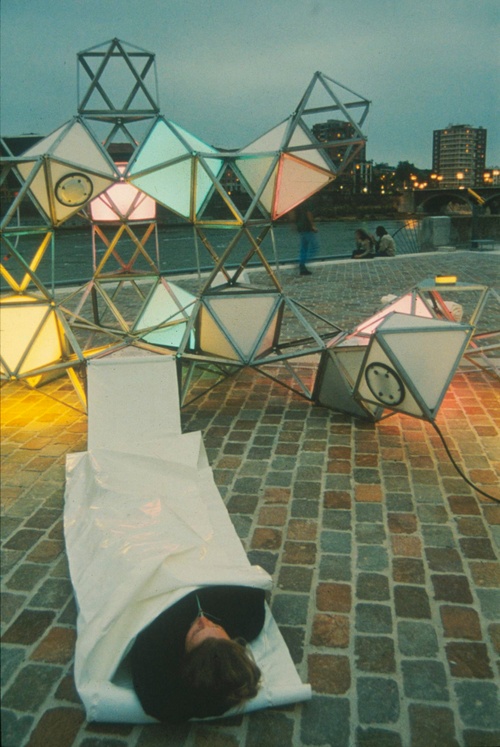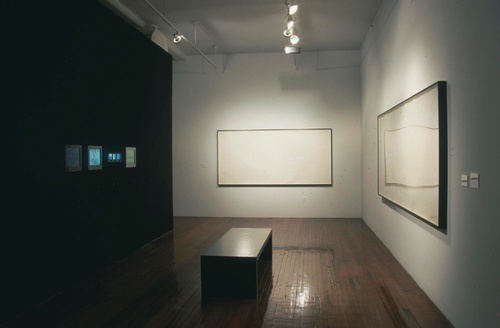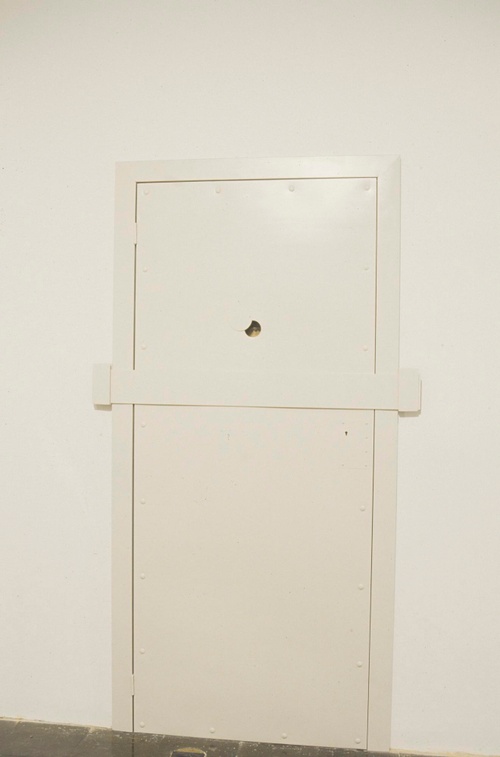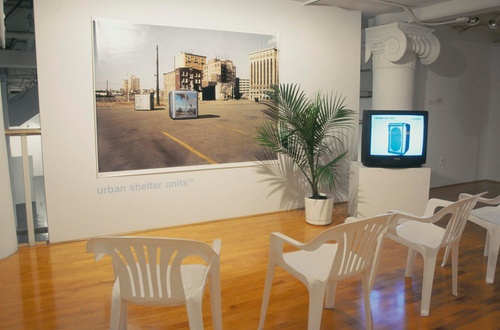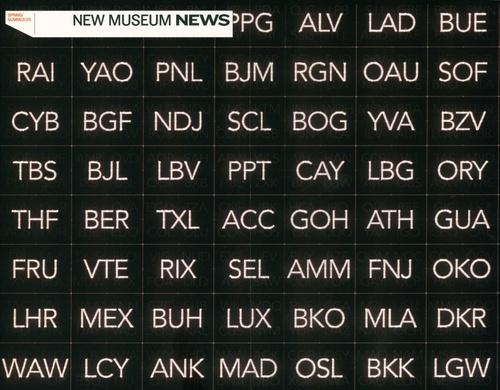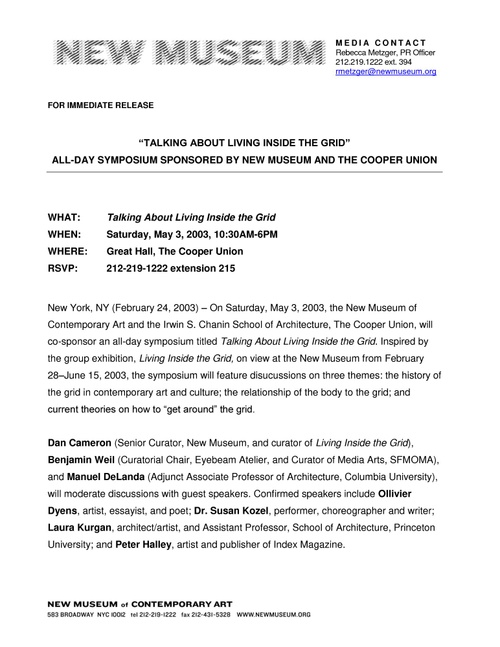Living Inside the Grid
Living Inside the Grid
The inhabited grid has become an irreducible sign of the world we live in. From our morning commutes-whether in a car moving along a highway, a high-speed train on a magnetic rail, or a walk through city streets-all the way to the last check of our e-mails at night, we operate in an overlapping network of grids. In both obvious and hidden ways, these grids order our movements, work, thoughts, leisure time, and even our dreams.
Living Inside the Grid was the first museum examination of the various ways that the grid-once exclusively associated with abstract art-is being used by a broad range of contemporary artists to incorporate figurative content. On view here were works of twenty-four single and collaborating artists from twelve countries; together they demonstrated how the “inhabited grid” has developed from an obscure tangent of modern art practice into an international phenomenon, linking many different stylistic approaches. The majority of these artists were presenting work in a U.S. museum for the first time.
Living Inside the Grid responds to two recent developments. First, the rapid rise of a globally linked society has presented a challenge to contemporary artists to describe or depict the experience of living in a world where the ubiquitous visible grid of urban design, railroads and highways has been reinforced or even surpassed by the invisible grid of telecommunications.
Second, a change in the work of a number of younger artists who live and work far apart from one another became apparent several years ago. By the early 1990s there was a significant diminishing of the distinction between geometric and figurative art reflecting a hybrid approach to two previously distant traditions.
A vivid, even tactile version of the transformed grid greets visitors as soon as they enter the New Museum’s lobby. A site-specific work by the Brazilian artist Ana Maria Tavares transforms this public zone into a frenzy of repeated patterns, reflected surfaces, space-age furniture, and a futuristic animated projection. Tavares, who frequently works directly with the spaces of modernist architecture, has created a powerful blend of site and artwork. To reinforce this ambiguity, some elements of Tavares’s work are participatory, while others suggest a permanent state of high-tech languidness.
On entering the ground-floor gallery, one first encounters the work of Jennifer Bolande, a New York sculptor and photographer, whose three wall-mounted constructions explore different facets of the connection between private and public spaces. In Bolande’s most recent work-a maquette made from pieced-together photos of windows forming a curved relief-nearness and distance are made to inhabit the same space. Danish sculptors Michael Elmgreen and Ingar Dragset, whose collaborations address the visual paradox of a “Powerless Structure,” have produced a simulation of a prison wall and cell door–the viewer peers through a metal grating to see the “prisoner” inside. For Elmgreen and Dragset, this depiction of a prison cell is the ultimate expression of the role of the grid in society, but one that most people have never encountered and even here are still prevented from trespassing on the prisoner’s intimate space.
Three photos from the German photographer Egbert Trogemann’s ongoing series of group portraits of TV studio audiences offer a different kind of prison experience. Photographed moments before the program’s host appears and the program begins, Trogemann’s work shows how the incorporation of a “live” audience is meant to intensify the illusion of a communal event that includes the viewers at home. As tokens of the media’s claim to inclusiveness, those in the studio audience are voluntary prisoners in a kind of social fiction. The last work in this room is a performance staged for video by the late Israeli-French artist Absalon, who in the late 1980s and early 1990s created enclosed sculptural spaces intended for the viewer’s habitation, along with performances that appeared set within these domestic ‘capsules.’ At the core of Absalon’s investigation is a profound mistrust of society’s tendency to blur the boundaries between private gesture and public act.
Entering the second ground-floor gallery, one encounters four artists’ projects in close proximity. José Damasceno, a Brazilian artist who breaks down contemporary objects into constituent parts and then reassembles them, is represented here by a metal floor sculpture that converts the brightly colored individual sections of a pie-chart graph into a star. Alongside this is a large wall drawing that transforms hundreds of vinyl numerals into a fanciful landscape. Occupying a corner of the space dominated by Damasceno’s work is an unobtrusive sculpture by the American artist Rita McBride, whose work often functions as a kind of structural dialogue with the architectural space in which it is presented. Her Marble Conduit–titled to play on the notion of art’s functional role–rises from the floor to the gallery ceiling and “continues” in the second floor gallery above. On an adjacent wall, the New York artist Danica Phelps presents a recent serial work based on her visit last year to Europe to see Documenta, the art exhibition held every five years in Kassel, Germany. Phelps documents her daily activities and expenditures, as well as encounters with other artists and her exchange of works with them. The series on view accumulates myriad detail in order to depict a system by which daily life can be lived interactively. In the elaborately executed drawings of British artist Paul Noble, shown close to Phelps’s works, viewers are introduced to an imaginary society, Nobson Newtown, in which most natural and architectural forms are reduced to the animated words and letters of a distorted alphabet. The drawings selected for this exhibition detail Nobson’s underground sewage lines, lavishing loving attention on a part of the urban grid usually kept safely out of sight. Camille Utterback’s interactive video projection work, External Measures, requires two or more viewers to change position within its camera range in order to activate a plotting mechanism installed in the ceiling, this technology captures the image in real time and transforms it into a colorful abstract projection created out of the “found” choreography of the viewers’ actions. In its evocation of an idealized use of technology, Utterback’s work transforms the invisible grid into a playful response to the viewer’s whim. Sean Snyder, an American artist living in Berlin, is represented by an installation of architectural models, photographs, and mounted texts that document the construction, on the outskirts of Bucharest, Romania, of a mansion one-fifth longer, but otherwise identical to J.R. Ewing’s home in the TV show “Dallas.” Snyder’s premise is that American popular culture is so pervasive that its adaptation and exaggeration by other societies can lead to dangerously disproportionate gestures of excess. Although the large cross-shaped architectural sculpture at the end of the first floor by Italian artist Monica Bonvicini is comprised of recognizable materials from Home Depot and other similar sources, the artist’s transformation of familiar and accessible forms into an alienating and hostile presence derives from her critical investigation into the hidden ideologies of architecture.
On the mezzanine between the first and second floors, an installation work by the German artist Roland Boden centers on the mass production of portable urban shelter units that have multiple applications, including flexible shelters for the homeless. Boden’s premise is to produce safe habitable “capsules” that blend into their urban surroundings, would not be seen as detrimental to the aesthetics of the streets, and appeal to nomadic urban lifestyles. His installation, which incorporates inexpensive furniture, a video, and a photo mock-up of one of his shelters, conveys the ambience of a shelter in “daytime” mode. In the stairwell leading to the second floor, Spanish artist Rogelio López Cuenca has created a wall-based work that begins on the landing and climbs up the walls into the gallery above. López Cuenca’s work draws on expertise in graphic design and concrete poetry to critically analyze mass media’s propensity to avoid complex depictions of reality in deference to consumer tastes. Simulating such useful graphic forms as subway maps and time-lines, López Cuenca subverts the appearance of informational “objectivity” in favor of a witty and provocative dialogue with the viewer.
The first gallery on the second floor presents work in three different media by Douglas Blau, Uri Tzaig and Do-Ho Suh. Blau, a New York-based artist who started out as a critic and curator, has established a vast visual archive of movie stills, postcards, photographs, prints, and reproductions over the past decade. These are intended to encompass the entire history of the visual imagination. His art consists of precise arrangements of material from this archive, often hundreds of separate images, in accordance with a theme and its place within his iconographic cosmology. In the adjacent projection space, Israeli artist Uri Tzaig, known for performative works that transform the competitive spirit of sports and games into one of cooperation, presents a video work entitled Doors. Using projection through an opaque glass to create the illusion of a life-size revolving door through which workers enter and exit, the work features an animated bee that periodically flies in and out of the doors, defying the building’s efforts to create a sealed environment. Do-Ho Suh’s Closet I reproduces, to scale, the artist’s own standing closet, in a mesh netting which is attached to the ceiling and hangs limply in space. Suh, a Korean who works in New York, uses the ghostly presence of his own (absent) furniture to echo his parallel existence in another part of the city (with the actual furniture).
Facing the elevator are three drawings by Mark Lombardi, an American artist who worked in New York until his death in 1998. Lombardi schooled himself in the arcana of political scandals and used his graphic imagination to render that information in the form of large complex diagrams that detail the major players-individual and corporate–in such things as the Iran-Contra affair of the late 1980s. Adjacent to the Lombardi works (and a second video by Absalon) is a pair of photographs, one of two groupings of work by the Italian artist Luisa Lambri. Lambri has spent the last several years making detailed photos of modern and contemporary architecture. Unlike most architectural photographers, she is less interested in conveying concrete information about the buildings she chooses than in recording the entirely subjective experience of being within their spaces.
In a projection room directly behind Lambri’s photographs is a video installation by New York artist Rico Gatson. In recent years, Gatson has created a series of video works in which he takes fragments of well-known American movies, digitally manipulates them, and turns them into kaleidoscopic tapestries. Commenting on racial stereotypes in Hollywood, Gatson’s art points to the media’s ability to collectively entrap us to the point where we can barely discern its effects on our perceptions and behavior. Tomoko Takahashi, a Japanese artist based in London, is well known for her seemingly chaotic (but in fact carefully orchestrated) installations of large quantities of accumulated objects. The recent nine-monitor video work, Without Parade (9 screens), a collaboration between Takahashi and British artist Rupert Carey, is made from the documentation of a public event in Brixton, London, during which, over the course of a few delirious minutes, she and several other collaborators tossed more than a ton of shredded paper from the roof of a tower. N55, a four-artist collective from Denmark, has devoted the past ten years to developing a system of objects, furniture, and architectural forms that are cheap to produce, easy to assemble, and have virtually no negative environmental impact. This project combines these utilitarian and utopian elements in order to humanize the grid structure of public life, enabling people to freely manipulate the structure for their individual needs.
Beginning with a shared premise, the last two works in the exhibition reach quite different conclusions. Marko Peljhan, a Slovenian artist whose work is based on development of an alternative system for tracking the movements of satellites and aircraft in the sky, intends to transform a society driven by telecommunications into a more representative democracy. By setting up a tracking system in the museum, Peljhan introduces the problem of the over-aestheticization of high-tech art, which makes use of the latest technological developments without exposing their inner workings. In Langlands & Bell’s projection work Frozen Sky, we witness an image of the world as seen from the opposite direction of Peljhan’s: a shimmering tapestry of global travel destinations, each unique geographical reality reduced to its three-letter airport code. For this collaborative team from London, the reworking of the physical world into systems of social control does not mean that knowledge has lost its discursive value. Life within the grid has become inescapable, Langlands & Bell seem to argue: this daunting reality can be tempered only by making the surrounding structure as transparent as possible.
